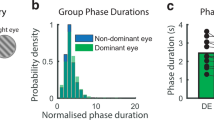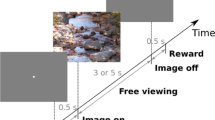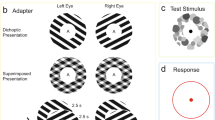Abstract
When dissimilar images are presented to the two eyes, they compete for perceptual dominance so that each image is visible in turn for a few seconds while the other is suppressed. Such binocular rivalry is associated with relative suppression of local, eye-based representations1,2,3,4 that can also be modulated by high-level influences such as perceptual grouping3,5,6. However, it is currently unclear how early in visual processing the suppression of eye-based signals can occur. Here we use high-resolution functional magnetic resonance imaging (fMRI) in conjunction with a new binocular rivalry stimulus to show that signals recorded from the human lateral geniculate nucleus (LGN) exhibit eye-specific suppression during rivalry. Regions of the LGN that show strong eye-preference independently show strongly reduced activity during binocular rivalry when the stimulus presented in their preferred eye is perceptually suppressed. The human LGN is thus the earliest stage of visual processing that reflects eye-specific dominance and suppression.
This is a preview of subscription content, access via your institution
Access options
Subscribe to this journal
Receive 51 print issues and online access
$199.00 per year
only $3.90 per issue
Buy this article
- Purchase on Springer Link
- Instant access to full article PDF
Prices may be subject to local taxes which are calculated during checkout




Similar content being viewed by others
References
Blake, R. & Logothetis, N. K. Visual competition. Nature Rev. Neurosci. 3, 13–21 (2002)
Blake, R., Westendorf, D. & Overton, R. What is suppressed during binocular rivalry? Perception 9, 223–231 (1980)
Lee, S. & Blake, R. A fresh look at interocular grouping during binocular rivalry. Vision Res. 44, 983–991 (2004)
Lehky, S. R. An astable multivibrator model of binocular rivalry. Perception 17, 215–228 (1988)
Kovacs, I., Papathomas, T. V., Yang, M. & Feher, A. When the brain changes its mind: interocular grouping during binocular rivalry. Proc. Natl Acad. Sci. USA 93, 15508–15511 (1996)
Logothetis, N. K., Leopold, D. A. & Sheinberg, D. L. What is rivalling during binocular rivalry? Nature 380, 621–624 (1996)
Andrews, T. J., Halpern, S. D. & Purves, D. Correlated size variations in human visual cortex, lateral geniculate nucleus, and optic tract. J. Neurosci. 17, 2859–2868 (1997)
Schroeder, C. E., Tenke, C. E., Arezzo, J. C. & Vaughan, H. G. Binocularity in the lateral geniculate nucleus of the alert monkey. Brain Res. 521, 303–310 (1990)
Varela, F. J. & Singer, W. Neuronal dynamics in the visual corticothalamic pathway revealed through binocular rivalry. Exp. Brain Res. 66, 10–20 (1987)
Sengpiel, F., Blakemore, C. & Harrad, R. Interocular suppression in the primary visual cortex: A possible neural basis of binocular rivalry. Vision Res. 35, 179–195 (1995)
Lehky, S. R. & Maunsell, J. H. R. No binocular rivalry in the LGN of alert macaque monkeys. Vision Res. 36, 1225–1234 (1996)
Haynes, J. D. & Rees, G. Predicting the orientation of invisible stimuli from activity in primary visual cortex. Nature Neurosci. 8, 686–691 (2005)
Kamitani, Y. & Tong, F. Decoding the visual and subjective contents of the human brain. Nature Neurosci. 8, 679–685 (2005)
Levelt, W. J. Note on the distribution of dominance times in binocular rivalry. Br. J. Psychol. 58, 143–145 (1967)
Schneider, K. A., Richter, M. C. & Kastner, S. Retinotopic organization and functional subdivisions of the human lateral geniculate nucleus: a high-resolution functional magnetic resonance imaging study. J. Neurosci. 24, 8975–8985 (2004)
Sclar, G., Maunsell, J. H. & Lennie, P. Coding of image contrast in central visual pathways of the macaque monkey. Vision Res. 31, 1148–1157 (1990)
Tong, F. & Engel, S. A. Interocular rivalry revealed in the human cortical blind-spot representation. Nature 411, 195–199 (2001)
Polonsky, A., Blake, R., Braun, J. & Heeger, D. J. Neuronal activity in human primary visual cortex correlates with perception during binocular rivalry. Nature Neurosci. 3, 1153–1159 (2000)
Lee, S. H., Blake, R. & Heeger, D. J. Traveling waves of activity in primary visual cortex during binocular rivalry. Nature Neurosci. 8, 22–23 (2005)
Lee, S. H. & Blake, R. V1 activity is reduced during binocular rivalry. J. Vis. 2, 618–626 (2002)
Logothetis, N. K. & Wandell, B. A. Interpreting the BOLD signal. Annu. Rev. Physiol. 66, 735–769 (2004)
Andrews, T. J. Binocular rivalry and visual awareness. Trends Cogn. Sci. 5, 407–409 (2001)
Wales, R. & Fox, R. Increment detection thresholds during binocular rivalry suppression. Percept. Psychophys. 8, 827–835 (1970)
Watanabe, K., Paik, Y. & Blake, R. Preserved gain control for luminance contrast during binocular rivalry suppression. Vision Res. 44, 3065–3071 (2004)
Sobel, K. V., Blake, R. & Raissian, T. A. Binocular rivalry suppression does impede buildup of the motion aftereffect. J. Vis. 4, Abstract 243 (2004)
Blake, R. & Fox, R. Adaptation to invisible gratings and the site of binocular rivalry suppression. Nature 249, 488–490 (1974)
Fang, F. & He, S. Cortical responses to invisible objects in the human dorsal and ventral pathways. Nature Neurosci. advance online publication, 4 September 2005 (doi:10.1038/nn1537).
Ichida, J. M. & Casagrande, V. A. Organization of the feedback pathway from striate cortex (V1) to the lateral geniculate nucleus (LGN) in the owl monkey (Aotus trivirgatus). J. Comp. Neurol. 454, 272–283 (2002)
Singer, W. Control of thalamic transmission by corticofugal and ascending reticular pathways in the visual system. Physiol. Rev. 57, 386–420 (1977)
Montero, V. & Zempel, J. The proportion and size of GABA-immunoreactive neurons in magnocellular and parvocellular layers of the lateral geniculate nucleus of the monkey. Exp. Brain Res. 62, 215–223 (1986)
Kastner, S. et al. Functional imaging of the human lateral geniculate nucleus and pulvinar. J. Neurophysiol. 91, 438–448 (2002)
Acknowledgements
This work was supported by the Wellcome Trust. We thank J. Driver and P. Sterzer for comments, and E. Freeman for advice regarding the stimuli. Author Contributions J.-D.H. and G.R. conceived the experiment, R.D. wrote the pulse sequence and J.-D.H. carried out the experiment and data analysis. G.R., J.-D.H. and R.D. co-wrote the paper.
Author information
Authors and Affiliations
Corresponding author
Ethics declarations
Competing interests
Reprints and permissions information is available at npg.nature.com/reprintsandpermissions. The authors declare no competing financial interests.
Supplementary information
Supplementary Figure S1
Distribution of ocular biases in LGN and V1 under monocular viewing conditions. (DOC 60 kb)
Supplementary Figure S2
Event-related BOLD-fMRI signal changes time-locked to rivalry transitions for individual subjects. (DOC 113 kb)
Supplementary Figure S3
Results of control experiment with monocular stimulation. (DOC 42 kb)
Supplementary Figure S4
Correlation between percept-preference and eye-selectivity. (DOC 64 kb)
Supplementary Methods
Additional description of Methods used in this study that could not be included in the main text. (DOC 30 kb)
Rights and permissions
About this article
Cite this article
Haynes, JD., Deichmann, R. & Rees, G. Eye-specific effects of binocular rivalry in the human lateral geniculate nucleus. Nature 438, 496–499 (2005). https://doi.org/10.1038/nature04169
Received:
Accepted:
Published:
Issue Date:
DOI: https://doi.org/10.1038/nature04169
This article is cited by
-
Tactile information affects alternating visual percepts during binocular rivalry using naturalistic objects
Cognitive Research: Principles and Implications (2022)
-
Cortical and subcortical signatures of conscious object recognition
Nature Communications (2021)
-
Magnetoencephalographic Correlates of Perceptual State During Auditory Bistability
Scientific Reports (2018)
-
Pre-coincidence brain activity predicts the perceptual outcome of streaming/bouncing motion display
Scientific Reports (2017)
-
Binocular Rivalry: A Window into Cortical Competition and Suppression
Journal of the Indian Institute of Science (2017)
Comments
By submitting a comment you agree to abide by our Terms and Community Guidelines. If you find something abusive or that does not comply with our terms or guidelines please flag it as inappropriate.



